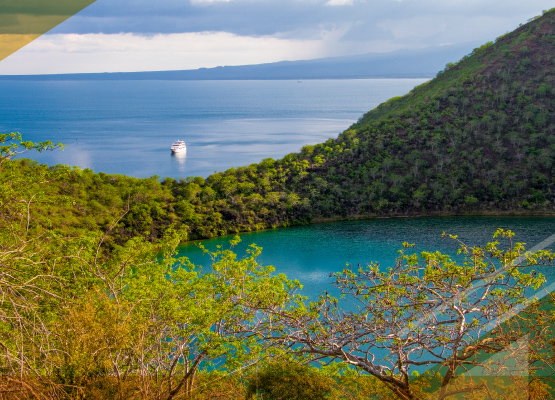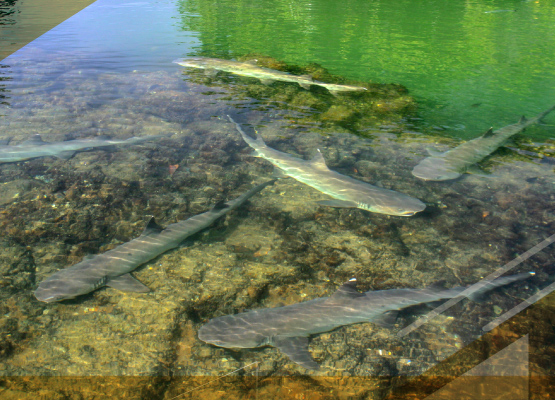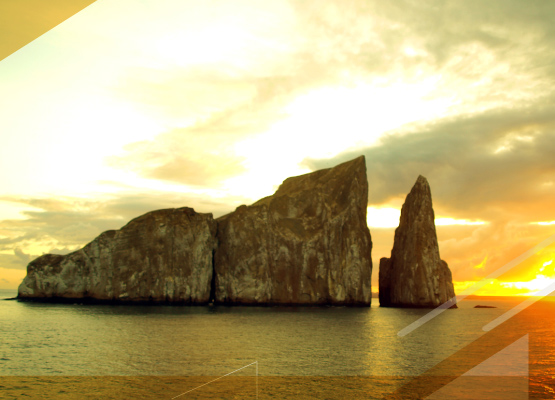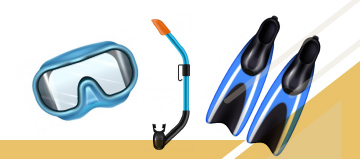
What about snorkeling in the Galapagos?
The Galapagos Islands is an absolute paradise for those who love to explore the underwater world. The best part? You do not have to be an expert diver in order to enjoy all the beauty the archipelago has to offer. Snorkelling allows you to get up close to amazing marine life. From friendly green sea turtles and playful Galapagos sea lions to golden eagle rays and even tranquil sharks!
We put together a list with the best spots for snorkelling around the islands, ranked from easiest to hardest. We´ve included the animals you will be able to see there, the best months for doing it, and some handy overall advice. Are you ready? Let’s jump right in!
THE BEST SNORKELING SITES IN THE GALAPAGOS.
Pinnacle Rock (Currents: 🌊)
Pinnacle Rock on Bartolome Island is very easily accessible. You swim straight of Golden Beach into the shallow cove where you are surrounded by precious coral formations and colourful reef fish. Around Pinnacle Rock (harmless) whitetip reef sharks rest on the seabed near spectacular lava formations, and Pacific green turtles and sea lions are also frequently spotted. If lucky, you might also encounter the endangered Galapagos penguin since the warm equatorial waters are one of their favourite breeding areas.


Tagus Cove (Currents:🌊)
(only accessible onboard a cruise)
Located on Isabela Island, the bottom of Tagus Cove is covered in green algae which attracts a wide variety of marine life such as marine iguanas and the rare flightless cormorant. Because of its calm waters, sea turtles and Galapagos Penguins like to visit this site as well to feed on the algae. If you can hold your breath long enough, you might be amongst the lucky ones to spot a yellow seahorse! Although, these tiny creatures are excellent at camouflaging themselves so that it seems they are one with the seaweed below.
Punta Espinoza (Currents:🌊)
(only accessible onboard a cruise)
Another location that provides excellent Galapagos snorkelling is located on the western side of Fernandina Island. What makes this place so special is the Cromwell Current that essentially hits the Bolívar Channel from the sea bottom up, releasing phytoplankton that travels all the way to the surface of the ocean. This plankton enables the creation of a food chain that attracts from smaller marine life to bigger species such as; dolphins, rays, hammerhead sharks, and sometimes even whale sharks and orcas (seasonally). Snorkelling at Espinoza Point you can encounter marine iguanas (who live there in large numbers), huge sunfish, sea turtles, manta rays, Galapagos penguins, and the endangered Flightless Cormorant.


Los Tuneles (Currents:🌊)
(only accessible via a land-based tour)
Located on Isabela Island this snorkelling site is truly one of a kind. A flooded labyrinth of channels and black lava sculptures form surrealistic plateaus, arches, and caves in which white-tip reef sharks, Pacific green turtles and Galapagos penguins like to swim around. The rocky shoreline is also great for spotting blue-footed boobies, marine iguanas, and colourful crabs whilst floating around in the water.
North Seymour Island (Currents:🌊🌊)
The Seymour Channel, which separates Mosquera Islet from North Seymour, is one of the top deep-water snorkelling locations in the Galapagos. At the low basaltic cliffs, it is very common to spot whitetip reef sharks cruising in the shallow waters as well as plunge-diving blue-footed boobies and brown pelicans. Colourful fish such as the king angelfish, boxfish, and parrotfish swim around in these waters as well. You might even be able to spot a black-botched ray and scalloped hammerhead shark!


Prince Phillip’s Steps (Currents:🌊🌊)
(only accessible onboard a cruise)
This popular deep-water snorkelling spot is located on the northern island of Genovesa and is characterized by its steep rocky cliff. Jumping straight from the boat into the chilly water, you are sure to encounter large tropical fish such as parrotfish, butterflyfish, and unicorn fish, who have a long spike sticking out from their forehead, much like that of the mythical unicorn. Numerous shark species are also present in the waters at Prince Phillip´s Steps such as the hammerheads, next to rays and of course the playful Galapagos sea lions who are not afraid to get close to you.
Kicker Rock – Currents: 🌊🌊🌊
Without a doubt one of the most popular snorkelling sites in the Galapagos and for good reason! Just off the coast of San Cristobal, the deep waters around this magnificent landmark hold some spectacular marine life. Plunge into this chilly, tropical aquarium and see pass in front of you a formation of spotted eagle rays, Pacific green turtles, Galapagos sea lions, and up to four different species of sharks, such as hammerheads. If all those wonderful animals were not exciting enough already, you can also flipper your way through an impressive narrow tunnel of about 50 m/165ft long to the other side of the rock and encounter glowing jellyfish, colourful corals, anemones, and starfish on the way.


Devil’s Crown (Currents: 🌊🌊🌊)
(only accessible onboard a cruise)
Located on the island of Floreana, this snorkelling site is not for weak swimmers. Its strong currents make for a challenging but rewarding ride. The former volcanic crater has been eroded over time and all it is left are a couple of rocks that peek out from the water, sharing similarity to a crown from above (hence the name). In and around this crown a bounty of marine life can be found such as; moray eels, snappers, angelfish, golden rays, yellow-tailed grunts, and much more. Of course, the Galapagos sea lion and Pacific green turtle are frequently spotted here as well.
THE BEST TIME OF YEAR TO GO SNORKELING IN THE GALAPAGOS
To start off, there is no “wrong” time period to visit the Galapagos Islands and explore the underwater world. Spectacular marine life can be found all year round and it depends more on your preferences.
Do you prefer warmer ocean temperatures or you don’t mind wearing a wetsuit? Are you a good swimmer that can withstand strong currents or do you wish for the waters to be calmer? Depending on the answers to questions like these, you can choose when to visit the islands.

Dry/Cool Season: August to November
These are usually considered the top months for snorkelling. With marine life being at its most active you have high chances of spotting dolphins, whales surfacing, Galapagos penguins, and big schools of colourful tropical fish. That being said, the Humboldt Current is at its strongest as well, meaning rougher seas and less visibility below you. Wearing a full wetsuit is also recommended during this time of year because of the cooler water temperatures of around 72 ºF/22 ºC.

Hot/Wet Season: December to March
During these months the water temperatures are starting to rise to an average of 77 ºF/25 ºC and wearing a wetsuit may no longer be needed. There is still plenty of wildlife to see under the ocean’s surface, although whale species and most dolphins have already left the now warmer waters around the islands. In return, the sea currents are not as strong anymore which makes swimming easier and improves visibility.
SOME HANDY-DANDY SNORKELING TIPS


Tip 1: Practice your swimming
Even though snorkelling is a ton of fun, it can also be quite exhausting being out in the water for long periods of time. Why not visit your local pool (or lake/sea if that is available to you) a couple of times a week before your trip to build up your strength. It will surely help!

Tip 2: Pay attention to your surroundings
Make sure to stick your head out of the water a couple of times when you are swimming towards a sea turtle to assure you are still in range of the beach or the boat. Currents can be unpredictable.

Tip 3: Look but don’t touch
We know it is very tempting to get as close as possible to the amazing wildlife that can be seen in the Galapagos, but keeping your distance is very important. Touching them can be dangerous for you and the animal as some species are poisonous or can react in a defensive manner.

Tip 4: Better together
What is better than encountering a school of Yellowtail Surgeonfish by yourself? Encountering it together with your loved one or best friend! Snorkelling in pairs is not only more fun but it is also recommended, especially for beginners. With the slight chance of something going wrong, there is always someone there to help you.

Tip 5: The right equipment for your underwater adventure
Make sure to test out your snorkelling gear such as your mask and your flippers. If these items are too big or too small you might experience discomfort as you hit the water. A right snorkelling mask should not feel too tight or give you a headache, nor allow for the leaking of water. Try various until it comfortably fits your face width.
Last but not least, just have fun! Don’t worry if you don’t get the hang of it the first time, after a couple of tries, you will surely glide through the water like Ariel.
Be sure to check out the different routes of our expedition boats to see which one fits your travel preferences best. If you would like some more information about the Galapagos or our deals, do not hesitate to contact us!
Read also:
